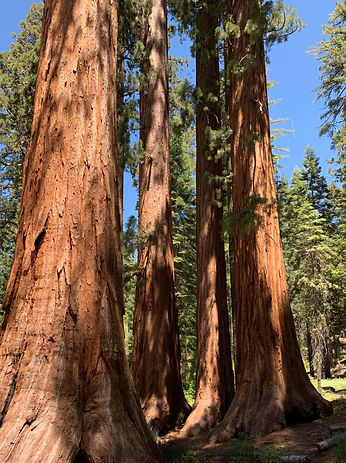
RESEARCH
Projects
Partitioning sources of mineral-associated soil organic matter in a tree common garden using stable isotopes
With colleagues from the Smithsonian Environmental Research Center, I took advantage of a mismatch in soil and tree carbon isotope values at the BiodiversiTREE common garden to investigate the sources of tree-derived carbon in mineral-associated organic matter. Together, we determined that trees contribute to mineral-associated soil carbon pools primarily through the activity of living roots, while leaf litter promotes the formation of particulate organic carbon.
This work is in press at New Phytologist

Smithsonian Environmental Research Center:
Variable bulk density calculations hinder large-scale data integration efforts for global soil carbon estimation
Using soil carbon data from the USDA Forest Service Forest Inventory and Analysis Program, I conducted a study showing how estimates of soil organic carbon content in the contiguous U.S. vary widely with different methods of calculating soil bulk density. These variations are common from study to study and are rarely documented well enough to allow data harmonization for landscape-scale soil carbon estimates.
This work is published in Biogeochemistry Letters.

Controls on the formation and persistence of mineral-associated organic matter (MAOM)
I collaborated with Dr. Rich Phillips (Indiana University) and Dr. Jennifer Pett-Ridge (Lawrence Livermore National Lab) to answer key questions about the stability of carbon on soil minerals in ecosystems across the U.S. Using soil collected at sites within the NEON network, we characterized the conditions that favor MAOM formation to understand the potential drivers of its long-term persistence.
This work is published in Journal of Ecology and was featured on the NEON blog.
This work was supported by a NSF Postdoctoral Research Fellowship in Biology and conducted in cooperation with the National Ecological Observatory Network.

Biomass allocation within trees with different mycorrhizal associations
In collaboration with Fiona Jevon (Yale University), I drew upon two large-scale datasets--the BAAD tree biomass and allometry database and the FungalRoot database of plant mycorrhizal associations--to investigate how tree biomass allocation varies in trees associated with arbuscular mycorrhizal vs. ectomycorrhizal fungi.
This work is published in Ecology, and all code and data can be accessed via GitHub.

Linking aboveground and belowground diversity in temperate hardwood forests
With colleagues Liz LaRue, Songlin Fei, Stephanie Kivlin, Rich Phillips, and others, I identified links between soil microbial community diversity and structural diversity of forest canopies across Indiana. Among other findings, we saw that the species richness of ectomycorrhizal fungi is positively associated with canopy complexity in the forests we studied.
This work is published in Ecosphere and was featured in the U.S. Forest Service Rooted in Research Newsletter.

DISSERTATION RESEARCH
Soil carbon stabilization beneath trees of varying litter quality and mycorrhizal associations
What controls whether soil carbon is protected for long-term sequestration? Recent work suggests microbial communities may play a key role in the fate of soil organic matter as either particulate organic matter (POM) or mineral-associated organic matter (MAOM). I tested how both litter quality and mycorrhizal associations of trees influence the stabilization of carbon on mineral surfaces in soil from forests across New Hampshire and Vermont.
This work is published in Ecosystems, and data from this project can be accessed through the Environmental Data Initiative data portal.

Leaf litter decomposition along a forest mycorrhizal gradient
Most litter decomposition is carried out by free-living soil fungi, yet mycorrhizal fungi of dominant forest trees may affect the rate of litter decay through a variety of direct and indirect pathways. With this project, I tested how the mycorrhizal association of nearby trees influences the decomposition rate of four species of leaf litter in a forest.
This work is published in New Phytologist, and data from this project can be accessed through the Environmental Data Initiative data portal.

Mycorrhizal fungi influence soil respiration in northern forests
Carbon efflux from forest soil is highly variable in space and time. While most ecosystem models use climate variables as the primary drivers of respiration rates, plant and microbial communities influence these patterns as well. With this project, I examined the role of fine roots and mycorrhizal fungi as drivers of soil respiration in a northern hardwood forest, and found that soil beneath AM-associated trees respires roughly 30% more carbon as CO2 compared to soil beneath ECM-associated trees.
This work is published in Ecosystems, and data from this project can be accessed through the Environmental Data Initiative data portal.

Previous work
Before my dissertation work, I had the opportunity to collaborate on several projects related to soil and sediment biogeochemistry:
Read about methane emissions from permafrost thaw ponds in Abisko, Sweden.
Read about soil nitrogen dynamics in successional forests of the White Mountains, New Hampshire.
